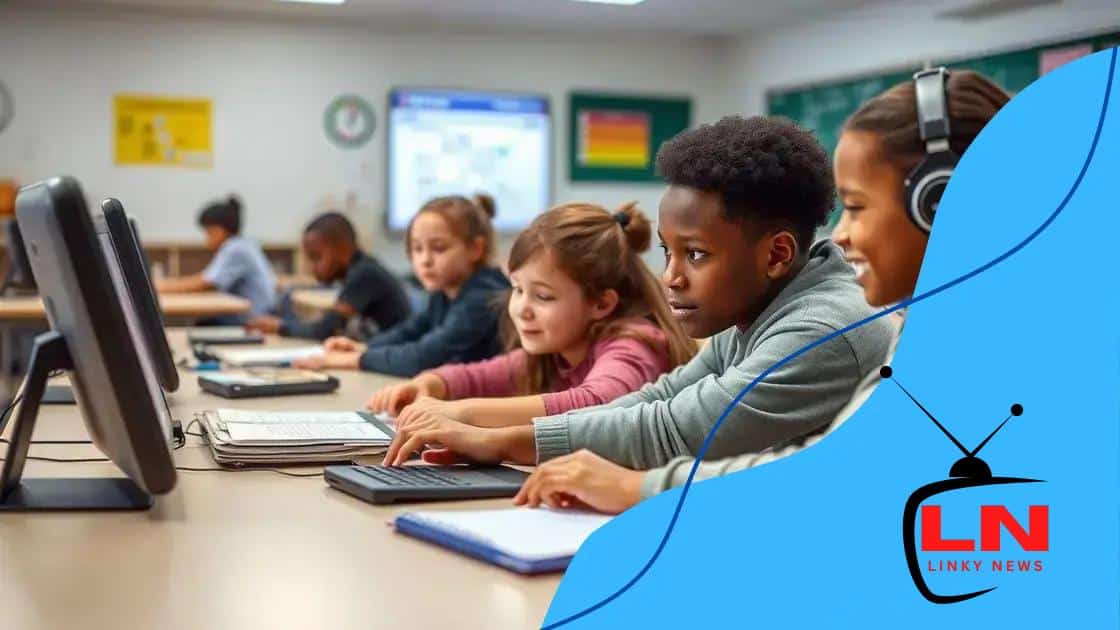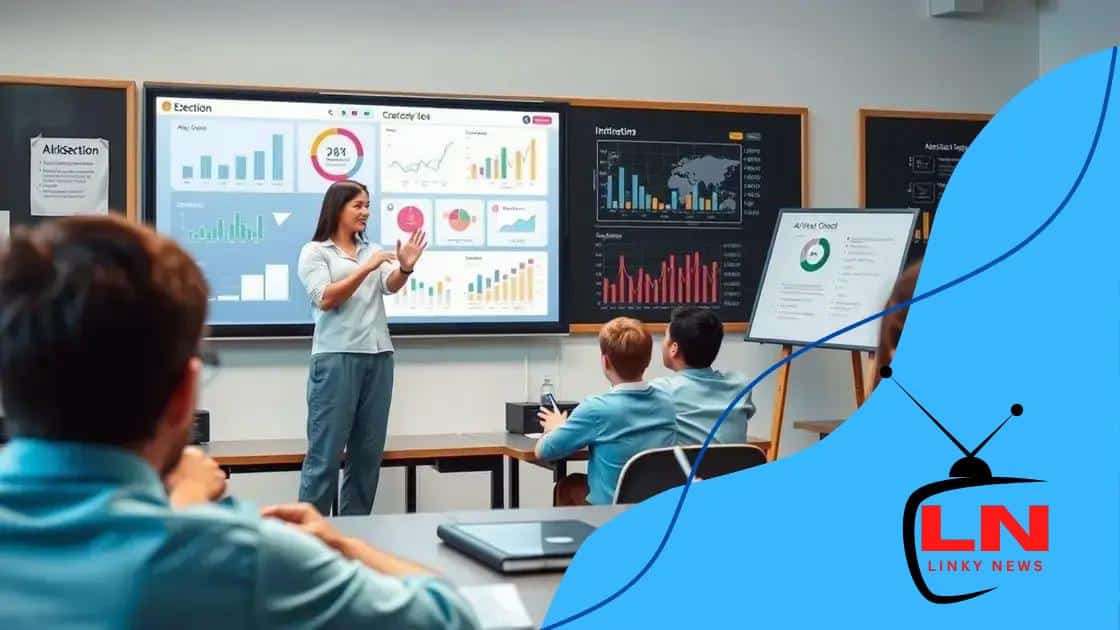AI student engagement tracking: improving classroom interaction

AI student engagement tracking uses advanced tools to analyze student participation and tailor learning experiences, significantly enhancing educational outcomes and making learning more effective and interactive.
AI student engagement tracking is changing how educators connect with their students. Have you noticed any patterns in classroom participation? This innovative approach could be the key to enhancing interaction and ensuring all voices are heard.
Understanding AI student engagement tracking
Understanding AI student engagement tracking is crucial for modern education. This innovative approach helps teachers monitor and enhance how students interact in the classroom.
By utilizing various tools, educators can gain insights into student behavior. These insights allow for personalized learning experiences that cater to individual needs.
Key Features of AI Engagement Tracking
Some key features of these systems include:
- Real-time data collection from various learning platforms.
- Analysis of student participation and performance trends.
- Identification of students who may need additional support.
This information helps teachers adjust their teaching strategies effectively. Additionally, it fosters a more inclusive environment where every student can thrive.
Benefits of Implementing AI Tracking
The benefits of implementing AI student engagement tracking in the classroom are numerous. Here are a few:
- Increased student motivation and participation.
- Better identification of learning gaps.
- Enhanced communication between teachers and students.
These advantages illustrate how AI can make education more effective and enjoyable. Utilizing AI tracking tools enables educators to understand better how engagements impact learning outcomes.
Engagement tracking can also lead to innovative teaching methods. By analyzing data, educators gain the ability to see trends and adapt lessons accordingly. A data-driven approach to teaching creates a responsive classroom atmosphere.
Benefits of tracking engagement with AI
Tracking engagement with AI opens doors to numerous benefits for both teachers and students. It allows educators to understand how each student learns and participates.
One major benefit is the ability to personalize learning. When teachers see which students engage the most, they can tailor their lessons to meet different needs. This targeted approach fosters a more supportive classroom environment.
Enhancing Student Performance
By tracking engagement, teachers can identify patterns in student performance. This helps inform teaching strategies and aids in providing timely feedback.
- Early identification of students who may be struggling.
- Opportunities to provide intervention or extra help.
- Clearer metrics to measure student progress.
As engagement levels increase, overall student performance often improves too. Educators can better prepare students for assessments and real-world challenges.
Fostering Better Communication
Another notable benefit of tracking engagement with AI is enhanced communication. Teachers can easily share progress with students and parents.
- Regular updates keep families engaged in the learning process.
- Encourages collaboration between teachers and parents.
- Helps students take ownership of their learning.
This dynamic exchange enriches the educational experience. It not only motivates students but also builds partnerships that are vital for student success.
Tools for effective AI engagement tracking

Using the right tools for effective AI engagement tracking can greatly enhance the learning experience. Various software and applications are designed to help teachers monitor student participation and engagement levels.
These tools collect data in real time, giving educators instant feedback. This empowers them to make informed decisions about their teaching methods. Having access to this data creates a more responsive classroom.
Popular Tools for Tracking Engagement
Several tools stand out in the realm of student engagement tracking:
- ClassDojo: This platform allows teachers to track student behavior and participation easily.
- Google Classroom: Offers insights on assignments and student interactions.
- Edpuzzle: Enables teachers to track student video engagement.
These tools integrate seamlessly into existing teaching frameworks. They not only help manage classroom dynamics but also encourage student accountability.
Integrating AI with Existing Systems
Integrating AI tools with existing classroom systems can lead to enhanced learning outcomes. By using data analytics, teachers can adapt their lessons based on real-time feedback.
For example, if many students are struggling with a topic, the data can indicate the need for a different teaching approach. Additionally, these tools can support differentiated instruction, catering to the diverse needs of learners.
The use of AI in tracking engagement also reinforces a culture of continuous improvement. With ongoing feedback, students and teachers can both work together towards better educational outcomes.
Case studies: successful AI implementations
Case studies highlighting successful AI implementations in education provide valuable insights. These examples illustrate how educators effectively use AI tools to enhance student engagement and learning outcomes.
For instance, one notable case involved a middle school that adopted an AI-driven learning platform. This platform analyzed student performance data, helping teachers identify those who needed additional support. As a result, overall student engagement increased significantly.
Real-World Examples of AI in Schools
Several schools have successfully integrated AI into their programs:
- Example 1: A high school used an AI tool to personalize learning experiences based on individual student needs.
- Example 2: An elementary school implemented AI chatbots to assist with homework questions outside of class.
- Example 3: A university utilized AI analytics to track student engagement during online courses.
These schools reported improved attendance rates, better communication between students and teachers, and a clearer understanding of individual learning paths.
Impact of AI on Educational Outcomes
The impact of these AI implementations extends beyond engagement. Educators noted enhanced critical thinking skills among students, as they interacted with AI-driven platforms that challenged them.
In addition, teachers have more time to focus on instruction rather than administrative tasks. This increased efficiency allows them to address students’ unique needs more effectively. By analyzing patterns in student responses, educators can refine their teaching strategies and foster a more inviting classroom environment.
Future trends in AI and student engagement
Future trends in AI and student engagement are shaping the landscape of education. As technology advances, new tools will emerge, allowing for a more interactive learning experience.
One significant trend is the increased use of personalized learning algorithms. These algorithms adapt to each student’s unique learning style, making education more effective and engaging. With AI analyzing data, educators can tailor instructions to fit individual needs.
Integration of Virtual Reality (VR)
Virtual reality is set to transform the classroom experience. By immersing students in interactive environments, VR enhances engagement like never before.
- Enables hands-on learning experiences.
- Encourages collaboration among students.
- Facilitates learning in various subjects, from science to history.
This technology will give students the ability to explore complex concepts and scenarios in ways traditional methods cannot.
AI-Powered Analytics
As the use of AI increases, analytics will play a vital role in tracking student progress. AI-powered analytics can identify trends in student engagement and performance.
Educators will be able to:
- Monitor engagement levels through various metrics.
- Receive real-time feedback on teaching effectiveness.
- Implement strategies to enhance student interaction based on data insights.
With these insights, teachers can create a more dynamic and responsive learning environment. The ability to assess engagement in real-time leads to significant improvements in student outcomes.
Another trend includes the rise of AI tutors. These digital assistants provide personalized support, helping students with homework and answering questions outside class hours. This trend indicates a shift toward more accessible education, where help is available 24/7.
As we look towards the future of AI and student engagement, the potential for enhancing educational experiences is immense. By embracing emerging technologies like personalized learning, virtual reality, and AI-powered analytics, educators can better understand and meet the diverse needs of their students. These advancements not only foster greater engagement but also pave the way for more effective teaching methods. Imagine a classroom where every student receives the support they need, thanks to real-time data and interactive tools. The future is bright, and embracing these changes will lead to a more inclusive and impactful learning environment.
FAQ – Frequently Asked Questions about AI and Student Engagement
How does AI personalize student learning?
AI personalizes learning by analyzing each student’s performance and adapting content to their individual needs, allowing for more targeted instruction.
What role does virtual reality play in student engagement?
Virtual reality immerses students in interactive learning environments, enhancing engagement and providing hands-on experiences that traditional methods cannot offer.
How can teachers use real-time data from AI?
Teachers can use real-time data to track student engagement, identify trends, and adjust their teaching strategies to improve student outcomes.
What are AI tutors and how can they benefit students?
AI tutors are digital assistants that provide personalized support to students, helping them with questions and homework outside of classroom hours.





